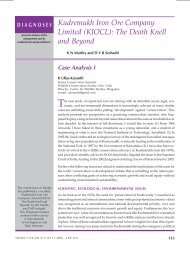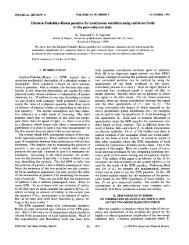Phase Transfer Catalysis - Publications of the IAS Fellows
Phase Transfer Catalysis - Publications of the IAS Fellows
Phase Transfer Catalysis - Publications of the IAS Fellows
Create successful ePaper yourself
Turn your PDF publications into a flip-book with our unique Google optimized e-Paper software.
Homogeneous Solubiiization<br />
Heterogeneous Solubiiization<br />
Figure 3. Mechanism <strong>of</strong> SLPTC.<br />
interact with <strong>the</strong> solid surface directly but exchanges <strong>the</strong> anion<br />
with M+ Y- dissolved in <strong>the</strong> organic phase, and <strong>the</strong>n ferries<br />
<strong>the</strong> Y- into <strong>the</strong> organic bulk in <strong>the</strong> form <strong>of</strong> Q+ Y-. Although<br />
this mechanism alone cannot account for <strong>the</strong> large<br />
enhancements observed in <strong>the</strong> presence <strong>of</strong> catalytic amounts<br />
<strong>of</strong> PT agents, it cannot be ruled out completely, especially in<br />
cases where <strong>the</strong> nucleophilic salt has a finite solubility in <strong>the</strong><br />
organic phase and in cases where <strong>the</strong> PT catalyst cannot approach<br />
<strong>the</strong> solid surface easily and instead combines with dissolved<br />
MY to form Q+ Y-. Heterogeneous solubilization occurs<br />
by <strong>the</strong> transfer <strong>of</strong> <strong>the</strong> nucleophilic anion by a PT catalyst<br />
from <strong>the</strong> surface <strong>of</strong> <strong>the</strong> solid crystalline lattice to <strong>the</strong> organic<br />
phase. The quat reacts with <strong>the</strong> solid at its surface (or, in<br />
some cases, within <strong>the</strong> solid), pairs with <strong>the</strong> nucleophilic anion<br />
Y-, and ferries it into <strong>the</strong> organic bulk in <strong>the</strong> form <strong>of</strong><br />
Q+ Y-. This is followed by <strong>the</strong> organic reaction between<br />
Q+ Y- and RX in <strong>the</strong> liquid phase.<br />
Esikova and Yufit (199la,b) report a new mechanism for<br />
SLPTC, via <strong>the</strong> formation <strong>of</strong> adsorption complexes. This involves<br />
a series <strong>of</strong> adsorption steps at <strong>the</strong> solid reagent (KC1<br />
in <strong>the</strong>ir case) surface, giving intermediate adsorption com-<br />
adsorption constant values. Thus, according to this <strong>the</strong>ory,<br />
intermediate adsorption complexes are crucial to <strong>the</strong> SLPTC<br />
cycle. Ion exchange is not considered to be one <strong>of</strong> <strong>the</strong> steps<br />
preceding <strong>the</strong> organic-phase reaction, since in <strong>the</strong>ir reaction<br />
system analysis showed that solid KC1 cannot ion exchange<br />
with QBr. They report a correlation between free substitution<br />
energy and energy <strong>of</strong> <strong>the</strong> crystalline lattice. The cation in<br />
M+ Y- also affects <strong>the</strong> reaction rate, indicating that <strong>the</strong> solid<br />
salt participates directly in <strong>the</strong> rate determining step. The<br />
article raises some crucial issues in SLPTC which have been<br />
ignored before, such as <strong>the</strong> importance <strong>of</strong> <strong>the</strong> solid during<br />
reaction, influence <strong>of</strong> <strong>the</strong> salt product on solid-phase properties<br />
significance <strong>of</strong> crystalline lattice energy, and so on. With<br />
a high solid reagent/organic substrate ratio (as is common),<br />
<strong>the</strong> influence <strong>of</strong> <strong>the</strong> product would be minimal as <strong>the</strong> solidphase<br />
composition does not change much. However, in some<br />
cases, it might be important to consider <strong>the</strong> change in <strong>the</strong><br />
solid-phase composition with reaction. Esikova and Yufit<br />
(199la) explain <strong>the</strong> product hindrance as being due to <strong>the</strong><br />
binding <strong>of</strong> <strong>the</strong> quat species Q+X- with <strong>the</strong> product M+Xleading<br />
to unproductiue binding. On <strong>the</strong> o<strong>the</strong>r hand, adsorption<br />
complexes <strong>of</strong> Q+X- with M+X- lead to active catalysis<br />
or productive binding.<br />
Ano<strong>the</strong>r important aspect in solid-liquid systems is <strong>the</strong> role<br />
<strong>of</strong> water and its effect on <strong>the</strong> mechanism and kinetics <strong>of</strong> <strong>the</strong><br />
SLPTC cycle. Different <strong>the</strong>ories have been proposed to explain<br />
<strong>the</strong> role <strong>of</strong> water in SLPTC systems. Liotta et al. (1987)<br />
and Zahalka and Sasson (1989) reported a maximum in reaction<br />
rate for SLPTC systems with increasing amounts <strong>of</strong> water<br />
in <strong>the</strong> system. On <strong>the</strong> o<strong>the</strong>r hand, Zubrick et al. (1975)<br />
reported no effect <strong>of</strong> water, while Yadav and Sharma (1981)<br />
observed a decrease in conversion in <strong>the</strong> presence <strong>of</strong> traces<br />
<strong>of</strong> water. The omega-phase <strong>the</strong>ory (Liotta et al., 1987) proposes<br />
that traces <strong>of</strong> water enhance <strong>the</strong> rate <strong>of</strong> <strong>the</strong> PTC cycle<br />
due to solid dissolution in a thin aqueous film (called <strong>the</strong><br />
omega phase) formed around <strong>the</strong> solid surface. Only minute<br />
quantities <strong>of</strong> <strong>the</strong> PT catalyst are present in <strong>the</strong> organic phase<br />
( < 3%) with most <strong>of</strong> <strong>the</strong> crown e<strong>the</strong>r translocated onto <strong>the</strong><br />
surface <strong>of</strong> <strong>the</strong> inorganic nucleophilic salt. Trace quantities <strong>of</strong><br />
water facilitate <strong>the</strong> interaction between <strong>the</strong> crown and <strong>the</strong><br />
salt by breaking down <strong>the</strong> crystal lattice structure, and enhance<br />
<strong>the</strong> ion-exchange reaction. The complexation <strong>of</strong> <strong>the</strong><br />
crown in <strong>the</strong> organic phase with <strong>the</strong> solid nucleophilic salt<br />
was postulated to be <strong>the</strong> rate controlling step in <strong>the</strong> absence<br />
<strong>of</strong> water, whereas <strong>the</strong> organic reaction with pseudo-first-order<br />
kinetics becomes <strong>the</strong> controlling step in <strong>the</strong> presence <strong>of</strong> water.<br />
Thus, pseudo-zero-order reaction rate pr<strong>of</strong>iles were obtained<br />
in <strong>the</strong> absence <strong>of</strong> water, while a pseudo-first-order<br />
reaction rate pr<strong>of</strong>ile was obtained in <strong>the</strong> presence <strong>of</strong> water<br />
traces. A similar thin aqueous boundary layer <strong>the</strong>ory has been<br />
proposed by Arrad and Sasson (1988) to explain <strong>the</strong> role <strong>of</strong><br />
water traces in SLPTC. However, it should be noted that addition<br />
<strong>of</strong> excess water leads to lower reactivity due to increased<br />
hydration <strong>of</strong> anions.<br />
PTC in <strong>the</strong> presence <strong>of</strong> bases<br />
with possible intermediate rearrangement through six-center A large number <strong>of</strong> industrially important reactions involve<br />
cyclic transition states. A number <strong>of</strong> complex kinetic equa- <strong>the</strong> use <strong>of</strong> PTC in <strong>the</strong> presence <strong>of</strong> a base, usually aqueous<br />
tions are obtained based on different schemes for varying se- NaOH or solid K2C03. These include C-, N-, 0 and s-alquences<br />
<strong>of</strong> reagent adsorption, intermediate lifetimes, and kylations, isomerizations, H/D exchanges, additions, p- and<br />
618 March 1998 Vol. 44, No. 3 AIChE Journal
















